Frank Hamrick– Handcrafted Photobooks
By Arthur H. Bleich–
When Frank Hamrick was ten he traded his sister an old hat for a plastic 35mm camera she’d gotten from a kid on the school bus who’d gotten it from his father who’d gotten it from an auto dealer as a premium for test driving a car.
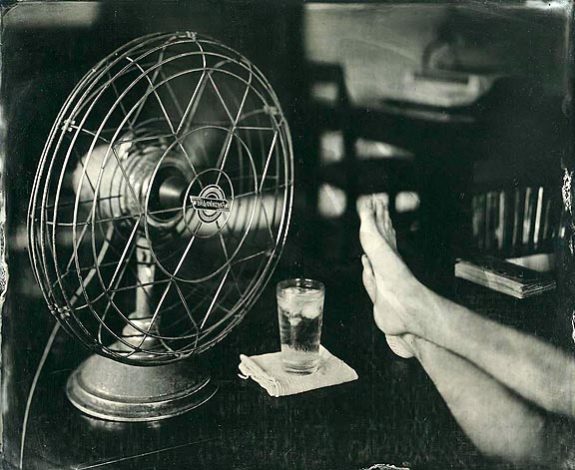
Tintype image © Frank Hamrick
And so began an illustrious arts career for this now-40-year-old “superstar of southern art,” an accolade bestowed by the prestigious Oxford American Magazine. His work mixes photography, storytelling, handmade books and found objects.
Hamrick is an Associate Professor of Art at Louisiana Tech University where he teaches photography and book arts and often uses Red River papers in bookmaking classes and to fabricate some of his eclectic books which sell for goodly sums. His images are shot both digitally and in a traditional process known as tintype. Here are some insights he recently shared.
AB: What kinds of pictures did you make after getting that camera from your sister?
FH: I photographed deer running away as I wandered through the woods with my dogs. What I did not understand at ten years old is that it is not possible to run after the deer and capture a sharp image at the same time. I made a lot of bad photographs because it was hard to separate myself from what I was experiencing. From time to time I would accidentally make a good one but did not know why.
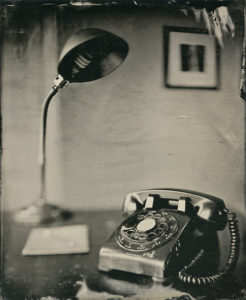
Tintype image © Frank Hamrick
AB: This changed as you went on?
FH: Yes, it did. Over time I realized how important it is for the viewer to relate to the image, to be able to insert themselves into the scene; the image begins a story and leaves room for the viewer to complete it.
AB: Can you give me a practical example?
FH: When I was a photography student at the University of Georgia one assignment was to photograph someone close to you and make viewers connect with the image. I chose my grandmother knowing that no one else in the photography class knew or cared about her– but if I photographed her the right way, viewers would see their own grandmother in the print and they would connect with the photograph. People have to relate to your images and somehow see their own lives in them.
AB: Let’s talk about your handmade fine arts books. How did they evolve?
FM: I thought it would be another way to get my photography out in the world. Previously I had put on exhibitions of large prints; people would come to the show, love the work but could not afford it. The book was different.
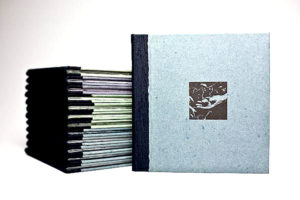
“Harvest” by Frank Hamrick. Limited, handcrafted edition.
AB: How?
FH: It was portable for everyone involved. I could carry one in my pocket as could those who bought it. You could hold it. Share it. It was a different way of experiencing the work– turning the pages rather than standing back several feet to stare at a print on the wall that was not to be touched. There was an entire body of work in each book and people connected with my work more when they saw multiple images sequenced together instead of looking at single photographs.
AB: Has your book concept changed over time?
FH: Yes. I have been able to incorporate text, letterpress, papermaking, paper staining and various bindings. Photographs are like songs. One image is a single you hear on the radio but a book is a complete album with liner notes and cover art. The sequence of work can convey the artist’s feeling in a way that does not usually come across when experiencing one piece of the puzzle by itself.
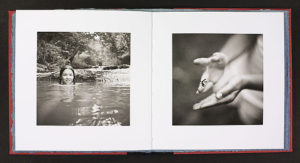
Pages from “Madalyn” by Frank Hamrick. Inkjet printed on Red River Paper.
AB: How long does it take to produce a book?
FH: There is no standard. For example, I made a book titled Madalyn, which was a fundraiser to help my niece with her first semester of college. It took a month going through my archives to find the images, sequence them and then do the actual work of printing and binding an edition of 25 books plus artist proofs.
AB: Are the book formats you use generally the same?
FH: No. It certainly would be easier if they were always the same size and number of pages but it would also become boring for my audience and myself. Each title is a challenge because there is something slightly different from one to the next.
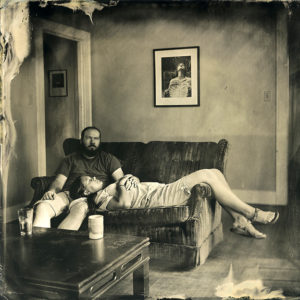
Tintype image © Frank Hamrick
AB: If one wanted to attempt a book such as you make, how would they begin and what would they need?
FH: First, you need good images. I like images that suggest beyond what they simply show. All images show something but the stronger images also suggest more than is seen. I love stories so I tend to gravitate toward images that tell ambiguous stories that go in various directions depending on who is looking at them.
AB: Going further, though, how do you start? Any good books or workshops to help a newbie get going?
FH: Keith Smith has published some books on making books by hand. Bookbinding for Book Artists [see Resources below] was the book recommended to me when I was first starting. There are also others.
AB: What Red River paper do you suggest using?
FH: Paper surfaces and weights vary according to each person’s needs. I suggest a paper that is heavy enough to hold up to being handled by people but not so heavy it cannot easily be folded. Red River’s double-sided 50lb matte is the paper I have used for several of my books, usually 8.5 x 14 inches, folded in half to make a 7” wide page.
AB: How many images do you usually use in a book?

Tintype image © Frank Hamrick
FH: My books tend to have a small selection of images. Past books have ranged between 6 – 24 images depending on the project. It is not unusual for good images to be left out of a book because it did not fit in the sequence and story told by that particular book. The last couple of books have been 20 pages with 17 or 18 images depending on the amount of text in the book.
AB: Student photographers always ask their mentors to reveal secrets of success. When they ask you, how do you answer?
FH: Do your best to maintain good relationships with people and leave them with positive memories of you. The people you like do not circle around through your life as much as you wish but the people you never want to see again will most definitely resurface– most likely in some position of power that can affect whether you get a show, a publication or a job. So don’t be a jerk.
RESOURCES
Books
For beginners– these books are easy to follow and lavishly illustrated:
Bookcraft by Heather Weston (Amazon, new, $17.00; used from $5.00.)
Book Art Studio Handbook by Stacie Dolin and Amy Lapidow (Amazon, new, $15.00; used from $2.00.)
For intermediates– who’ve already done some book crafting:
Bookbinding For Book Artists by Keith A. Smith and Fred Jordan. (Amazon, new $35.00; used from $20.00.)
Processes
Learn about the Tintype process.
Bookmaking Workshops
Find a bookmaking workshop near you.
Frank will be teaching a two week workshop at the Penland School of Crafts in Penland, North Carolina July 8th-20th, 2018.
Contact Information
Frank’s prints and books may be purchased here. His website is here. To receive his newsletter and workshop information email him at: fhamrick [at] me [dot] com
Original Publication Date: September 08, 2017
Article Last updated: September 08, 2017
Related Posts and Information
Categories
About Photographers
Announcements
Back to Basics
Books and Videos
Cards and Calendars
Commentary
Contests
Displaying Images
Editing for Print
Events
Favorite Photo Locations
Featured Software
Free Stuff
Handy Hardware
How-To-Do-It
Imaging
Inks and Papers
Marketing Images
Monitors
Odds and Ends
Photo Gear and Services
Photo History
Photography
Printer Reviews
Printing
Printing Project Ideas
Red River Paper
Red River Paper Pro
RRP Products
Scanners and Scanning
Success on Paper
Techniques
Techniques
Tips and Tricks
Webinars
Words from the Web
Workshops and Exhibits
all
Archives
January, 2025
December, 2024
November, 2024
October, 2024
September, 2024
August, 2024
July, 2024
June, 2024
May, 2024
more archive dates
archive article list




